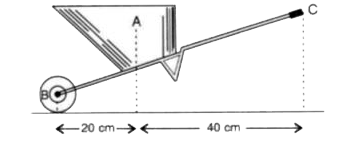Complete Solutions to EXERCISE-3(A) NUMERICALS of chapter MACHINES of Class 10 book with complete answers and questions
| Class 10 | PHYSICS |
| Chapter | MACHINES |
| SELINA PUBLICATION | EXERCISE-3(A) NUMERICALS |
| Number Of Questions | 12 |
| Academic Year | 2023-24 |
A crowbar of length 120 cm has its fulcrum situated at a distance of 20 cm from the load. Calculate the mechanical advantage of the crowbar.
View SolutionA pair of scissors has its blades 15 cm long, while its handles are `7*5cm` long. What is its mechanical advantage ?
View SolutionA force of 5 kgf is required to cut a metal sheet. A pair of shears used for cutting the metal sheet has its blades 5 cm long, while its handles are 10 cm long. What effort is needed to cut the sheet ?
View SolutionFigure below shows a lever in use.

(a) To which class of lever does it belong ?
(b) If AB=1m, AF=0.4m, find its mechanical advantage.
(c) Calculate the value of E.
View SolutionA man uses a crowbar of length 1.5m to raise a load of 75 kgf by putting a sharp edge below the bar at a distance of 1 m from his hand. (a) draw a diagram of the arrangement showing the fulcrum (F), load (L) and effort (E) with their direction. (b) state the kind of lever. (c) Calculate : (i) load arm, (ii) effort arm, (iii) mechanical advantage, and (iv) the effort needed.
View SolutionA pair of scissors is used to cut a piece of cloth by keeping it at a distance of 8.0 cm from its rivet and applying an effort of 10 kgf by fingers at a distance of 2.0 cm from the rivet.
(a) Find : (i) the mechanical advantage of the scissors, and (ii) the load offered by the cloth.
(b) How does the pair of scissors atc : as a force multiplier or as a speed multiplier ?
View SolutionA 4 m long rod of negligible weight is supported at a point 125 cm from its one end and a load of 18 kgf is suspened at a point 60 cm from the support on the shorter arm.
(a) If a weight W is placed at a distance 250 cm from the support on the longer arm to balance the rod, find W.
(b) If a weight 5 kgf is kept to balance the rod, find its position.
(c) To which class of lever does it belong ?
View SolutionA lever of length 9 cm has its load arm 5 cm long and the effort arm is 9 cm long. (a) to which class does it belong ?
(b) Draw a diagram of the lever showing the position of the fulcrum F and directions of both the load L and effort E. (c) what is the mechanical advantage and velocity ratio if the efficiency is 100%?
(d) What will be the mechanical advantage and velocity ratio if the efficiency becomes 50%?
View SolutionFigure below shows a lever in use

(a) To which class of levers does it belongs ?
(b) Without changing the dimensions of the lever, if the load is shifted towards the fulcrum what happens to the mechanical advantage of the lever ?
View SolutionFigure below shows a wheel barrow of mass 15 kg carrying a load of 30 kgf with its centre of gravity at A. the points B and C are the centre of wheel and tip of the handle such that the horizontal distance AB=20 cm and AC=40 cm.

Find: (a) the load arm, (b) the effort arm,
(c) the mechanical advantage, and (d) the minimum effort required to keep the leg just off the ground.
View SolutionFigure below shoes the use of a lever.

(a) State the principle of moments as applied to the above lever.
(b) To which class of lever does it belong ? Give an example of this class of lever.
(c) If FA=10 cm, AB=490 cm, calculate: (i) the mechanical advantage, and (ii) the minimum effort required to lift and load (=50N).
View SolutionA fire tongs has its arms 20 cm long. It is used to lift a coal of weight 1.5 kgf by applying an effort at a distance of 15 cm from the fulcrum. Find : (i) the mechanical advantage of the togns, and (ii) the effort needed.
View Solution
EXERCISE-3(A) NUMERICALS questions and complete solutions for chapter MACHINES of SELINA PHYSICS (ENGLISH) of Class 10